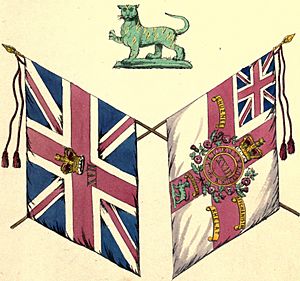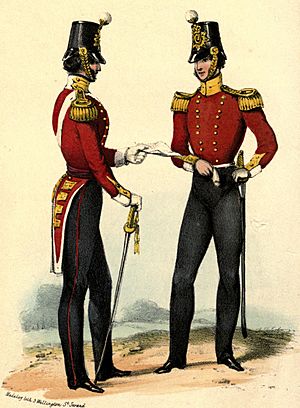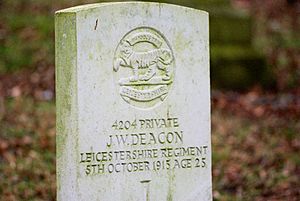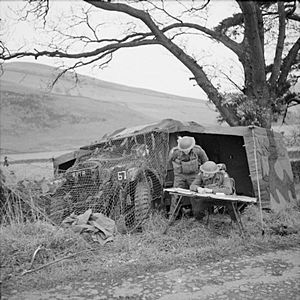Royal Leicestershire Regiment facts for kids
Quick facts for kids 17th Regiment of Foot17th (Leicestershire) Regiment of Foot Leicestershire Regiment Royal Leicestershire Regiment |
|
|---|---|
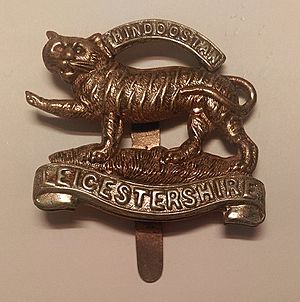
Badge of the Royal Leicestershire Regiment
|
|
| Active | 1688–1964 |
| Country | |
| Branch | |
| Type | Infantry |
| Role | Line infantry |
| Garrison/HQ | Glen Parva Barracks |
| Nickname(s) | The Tigers |
The Leicestershire Regiment was a famous British Army unit. It was also known as the Royal Leicestershire Regiment after 1946. This regiment had a long history, serving for over 270 years, from 1688 to 1964.
Soldiers from the regiment fought in many wars, including World War I and World War II. In September 1964, the Leicestershire Regiment joined with other regiments to form the Royal Anglian Regiment. Today, a part of the 2nd Battalion of the Royal Anglian Regiment continues the proud history of the Royal Leicestershire Regiment.
Contents
- A Look at the Regiment's History
- Early Battles and Adventures
- Fighting in North America and the West Indies
- The American War of Independence
- Becoming the Leicestershire Regiment
- Involvement in Australian Conflicts
- The Victorian Era and Reforms
- The First World War (1914-1918)
- Between the World Wars
- The Second World War (1939-1945)
- After the War and Amalgamation
- Regimental Museum
- Battle Honours
- Victoria Cross Heroes
A Look at the Regiment's History
Early Battles and Adventures
The regiment began on 27 September 1688 in London. At first, it was known by the name of its leader, like other regiments. One of its first missions was to help at the siege of Derry in 1689.
In 1693, the regiment went to Flanders to fight in the Nine Years' War. They took part in the attack on Fort Knokke and the siege of Namur before returning home in 1697.
In 1701, they moved to Holland for the War of the Spanish Succession. They fought in sieges at Kaiserswerth (1702), Venlo (1702), and Huy (1703). Then, in 1704, they went to Portugal and fought in several sieges, including Valencia de Alcántara and Badajoz in 1705. They also saw action at the Battle of Almansa in 1707.
By 1713, the regiment was ranked 17th in the army. They went to Scotland to stop the Jacobite rising of 1715 and fought at the Battle of Sheriffmuir in November 1715.
From 1726 to 1748, the regiment was stationed in Menorca and helped defend Gibraltar in 1727. After that, they moved to Ireland.
On 1 July 1751, the unit officially became the 17th Regiment of Foot.
Fighting in North America and the West Indies
In 1757, the regiment sailed to Nova Scotia to fight in the French and Indian War. They were part of the siege of Louisbourg in 1758 and the Battle of Ticonderoga in 1759. The next year, they helped capture Montréal in September.
They also fought in the West Indies in 1762 and during Pontiac's War before returning to England in 1767. By 1769, the regiment was strong and ready for duty.
The American War of Independence
After the fighting started at the Battle of Lexington and Concord, the regiment sailed from Ireland to Boston in 1776. They were evacuated from Boston to Halifax, Nova Scotia, after the Siege of Boston.
The regiment then sailed to New York and landed on Staten Island in July 1776. They fought in the Battle of Long Island in August 1776, and were part of the reserve forces at the Battle of White Plains and the Battle of Fort Washington in late 1776.
The Heroes of Princeton
The regiment also fought bravely at the Battle of Princeton in January 1777. Even though they were outnumbered, their leader, Lieutenant-Colonel Charles Mawhood, ordered an attack. They managed to defeat some enemy forces, but soon found themselves surrounded.
Mawhood ordered a daring bayonet charge to break through the enemy lines, and it worked! At the same time, Captain William Scott and only 40 men successfully defended the army's supplies against many more attackers. Their bravery was praised, and the regiment was later called "The Heroes of Prince-town" in recruiting ads.
The regiment continued to fight in other important battles, including the Battle of Brandywine (1777), the Battle of Germantown (1777), and the Battle of Monmouth (1778). In 1778, they took part in Grey's raid, destroying rebel supplies.
In July 1779, some companies and the regiment's flags were captured at the Battle of Stony Point. The remaining soldiers formed a new "17th Company" and fought in South Carolina. This company also fought in the last major battle of the war at the Battle of the Combahee River.
The main part of the regiment surrendered with General Cornwallis's army at the siege of Yorktown in September 1781.
Becoming the Leicestershire Regiment
In 1782, the regiment was given a county name to help with recruiting. It became the 17th (Leicestershire) Regiment of Foot. After the war, they moved to Nova Scotia and then back to England in 1786.
In 1799, the regiment grew to two battalions. Both fought in the Anglo-Russian invasion of Holland at the Battle of Bergen and the Battle of Alkmaar. The second battalion was later disbanded in 1802.
In 1804, the regiment went to India and stayed there until 1823. Because of their long service in India, they were given the badge of a "royal tiger" in 1825. They fought in the Gurkha War (1814-16) and the Third Maratha War (1817-18). From 1830 to 1836, the regiment was stationed in New South Wales, Australia.
Involvement in Australian Conflicts
During their time in Australia, the 17th Regiment was involved in conflicts with Aboriginal Australians. In 1831 and 1832, the regiment was involved in incidents on Moreton Island and Minjerribah in what is now Queensland.
In 1835, in response to violence, soldiers from the 17th Regiment were sent to the Gringai area north of Newcastle. Their mission was to stop the resistance.
The Victorian Era and Reforms
The regiment returned to India in 1837. They fought in the Battle of Ghazni and the Battle of Khelat in 1839 during the First Anglo-Afghan War. Later, they fought in the Crimean War at the siege of Sevastopol in 1854. In 1858, a second battalion was formed.

In 1881, the regiment officially became The Leicestershire Regiment. It also included local volunteer groups. The 1st and 3rd battalions fought in the Second Boer War from 1899 to 1902. The 2nd Battalion was stationed in Ireland and Egypt.
In 1908, the volunteer units were reorganized. The regiment now had one Reserve and two Territorial battalions. There was a small issue when new flags were given to the 1st Battalion. The old flags had a green tiger, but the new ones did not. The regiment refused to use the new flags until they were allowed to have a green tiger with gold stripes on them.
The First World War (1914-1918)
During the First World War, the Leicestershire Regiment grew from five to nineteen battalions! These battalions served in many places, including France and Flanders, Mesopotamia, and Palestine.
Regular Army Battalions
The 1st Battalion arrived in France in September 1914. They fought at the Battle of Hooge in July 1915 and suffered heavy losses at the Battle of the Somme in July 1916.
The 2nd Battalion also arrived in France in September 1914. They fought at the Battle of Neuve Chapelle in March 1915, where Private William Buckingham earned the Victoria Cross for his bravery. Later, they moved to Mesopotamia and took part in the siege of Kut and the fall of Baghdad in 1917. In 1918, they moved to Suez for the Palestine Campaign.
Territorial Force Battalions
The 1/4th and 1/5th Battalions arrived in France in early 1915. They fought at the action of the Hohenzollern Redoubt in October 1915. Lieutenant John Barrett was awarded the Victoria Cross for his actions in September 1918.
The 2/4th and 2/5th Battalions also arrived in France in February 1917.
New Army Battalions
Many new battalions were formed, like the 6th, 7th, 8th, and 9th (Service) Battalions. They arrived in France in July 1915 and fought in the attacks on High Wood at the Battle of the Somme in 1916. Lieutenant Colonel Philip Bent was awarded the Victoria Cross after he died in battle at the Battle of Polygon Wood in September 1917.
The 11th (Service) Battalion arrived in France in March 1916. The 14th (Service) Battalion also arrived in France in July 1918.
Between the World Wars

After the First World War, the regiment returned to its smaller size. The 1st Battalion was involved in the Irish War of Independence from 1920 to 1922, then moved to places like Cyprus, Egypt, and India. The 2nd Battalion served in India, Sudan, Germany, and Palestine.
In 1931, the regiment's facing colour (the colour of the uniform's lapels and cuffs) was changed from white to pearl grey.
The 3rd (Militia) Battalion was disbanded in 1953. In 1936, the 4th Battalion became a searchlight unit in the Royal Engineers. In 1939, the Territorial Army grew, and the 1/5th and 2/5th Battalions were formed.
The Second World War (1939-1945)
Regular Army Battalions
At the start of the Second World War, the 1st Battalion was in the Far East. They fought against the Imperial Japanese Army in the Malayan Campaign in early 1942 and suffered many losses. Many soldiers became prisoners of war. The battalion was reformed in May 1942.

The 2nd Battalion fought in the Western Desert Campaign at the Battle of Sidi Barrani in December 1940 and the Battle of Bardia in January 1941. They then moved to Greece and took part in the Battle of Crete in May 1941. After that, they went back to North Africa for the Battle of Tobruk in June 1941. In 1942, they moved to Ceylon and India, becoming part of the Chindits and fighting in the Burma Campaign.
Territorial Army Battalions
The 1/5th Battalion fought briefly in the Norwegian Campaign before returning to the United Kingdom and Northern Ireland for the rest of the war.
The 2/5th Battalion was formed in 1939. They fought in the Battle of France in 1940 and were part of the Dunkirk evacuation. They stayed in England for two and a half years before going to North Africa in 1943. They fought in the Tunisian Campaign, including the Battle of Kasserine Pass.
After a rest, they joined the Allied invasion of Italy. They fought bravely, suffering many casualties, and helped breach the Volturno Line in October. They also took part in battles around the Winter Line, including the famous Battle of Monte Cassino. In March 1944, they were moved to the Middle East to rest and retrain. They returned to Italy in July and fought on the Gothic Line. In December, they went to Athens, Greece, to help calm the Greek Civil War. They returned to Italy in April 1945, just before the war in Europe ended. The battalion was disbanded in 1946.
The 44th AA Battalion became the 44th (The Leicestershire Regiment) Searchlight Regiment in 1940, serving during the Battle of Britain and the Blitz. In 1942, it became the 121st Light Anti-Aircraft Regiment, Royal Artillery, and served in North West Europe.
War Service Battalions
The 7th Battalion was created in July 1940. It was mainly involved in defending beaches and anti-invasion duties. In September 1942, the 7th Leicesters were sent to India. The next year, they were chosen to be part of the Chindits, a special force. They participated in the second Chindit expedition in 1944, disrupting Japanese supply lines. Due to heavy losses, the battalion was disbanded on 31 December 1944.
The 8th Battalion was also created in July 1940 and had similar duties. In May 1942, it was renamed the 1st Battalion after the original 1st Battalion was destroyed. In July 1944, this reformed 1st Battalion joined the 49th (West Riding) Infantry Division, which was fighting in the Normandy Campaign. Their first major battle was the Second Battle of the Odon.
After the War and Amalgamation
In 1946, the regiment was given "royal" status, becoming the Royal Leicestershire Regiment. In 1948, the 2nd Battalion was removed, and the 5th Battalion (TA) was reformed. The regiment became part of the Forester Brigade.
The 1st Battalion served in the Korean War from 1951 to 1952. They then moved to England, Germany, Sudan, Cyprus, Brunei, and Aden.
In 1961, the Territorial units merged to become the 4th/5th Battalion.
In 1963, the Forester Brigade was dissolved, and the Royal Leicesters joined the East Anglian Brigade.
Joining the Royal Anglian Regiment
On 1 September 1964, the Royal Leicestershire Regiment became the 4th (Leicestershire) Battalion, The Royal Anglian Regiment. The battalion was stationed in Malta from 1965.
The "Leicestershire" name was removed in 1968, and the battalion was disbanded in 1975. However, the Royal Leicestershire heritage lives on in the new regiment's button design, which features the royal tiger.
Today, parts of the Royal Anglian Regiment continue the history of the Royal Leicestershire Regiment.
Regimental Museum
You can learn more about the Royal Leicestershire Regiment at the Newarke Houses Museum in Leicester.
Battle Honours
The regiment earned many special awards called battle honours for their bravery in different wars. These honours are often displayed on the regiment's flags.
- Earlier Wars
- Namur, 1695, Louisburg, Martinique, 1762, Havannah, Ghuznee, 1839, Khelat, Afghanistan 1839, Sevastopol, Ali Masjid, Afghanistan 1878–79, Defence of Ladysmith, South Africa, 1899–1902
- First World War (Ten selected honours, shown in bold type, were borne on the colours.)
- Aisne, 1914, '18, La Bassee, 1914, Armentieres, 1914, Festubert 1914, '15, Neuve Chapelle, Aubers, Hooge, 1915, Somme, 1916, '18, Bazentin, Flers-Courcelette, Morval, Le Transloy, Ypres, 1917, Polygon Wood, Cambrai, 1917, '18, St Quentin, Lys, Bailleul, Kemmel, Scherpenberg, Albert, 1918, Bapaume, 1918, Hindenburg Line, Épehy, St Quentin Canal, Beaurevoir, Selle, Sambre, France and Flanders, 1914–18, Megiddo, Sharon, Damascus, Palestine, 1918, Tigris, 1916, Kut-el-Amara, 1917, Baghdad, Mesopotamia, 1915–18
- Second World War (Ten selected honours, shown in bold type, were borne on the colours.)
- Norway, 1940, Antwerp-Turnhout Canal, Scheldt, Zetten, North-West Europe, 1944–45, Jebel Mazar, Syria, 1941, Sidi Barrani, Tobruk, 1941, Montaigne Farm, North Africa, 1940–41, '43, Salerno, Calabritto, Gothic Line, Monte Gridolfo, Monte Colombo, Italy, 1943–45, Crete, Heraklion, Kampar, Malaya, 1941–42, Chindits, 1944
- Korean War:
- Maryang-San, Korea, 1951–52
Victoria Cross Heroes
The following brave members of the Regiment were awarded the Victoria Cross, the highest award for military bravery:
- Lieutenant John Cridlan Barrett, First World War (24 September 1918)
- Lieutenant Colonel Philip Eric Bent, Belgium, First World War (1 October 1917)
- Private William Buckingham, First World War (10/12 March 1915)
- Corporal Philip Smith, Radan, Crimean War (18 June 1855)



